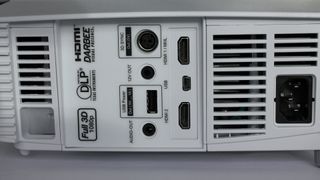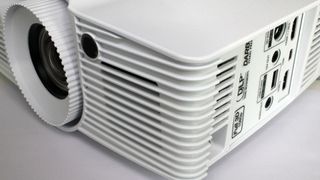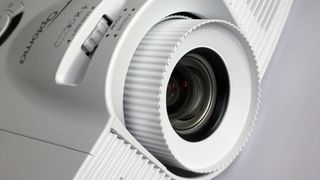TechRadar Verdict
With low input lag and image-boosting Darbee processing, this Full HD Special Edition DLP projector is more entertaining than a Marvel movie box set. It’s bright, bold and brilliant!
Pros
- +
Console-friendly low input lag
- +
Razor-sharp DLP images
- +
Bright enough for use in rooms with ambient light
Cons
- -
Black level is inevitably limited
- -
Operating noise is high in full brightness mode
Why you can trust TechRadar
The Optoma HD39Darbee is a multi-talented 1080p projector. Whether your idea of big screen nirvana is a movie marathon or esports with mates, Optoma's latest lightbox has equal appeal.
Hook up that Nintendo Switch and you’ll be amazed at just how good Zelda can look 100 inches wide. Prefer to get lost in popcorn action, it’ll do that too.
All things considered, at £899/$899 (around AU$1,140), the Optoma HD39Darbee Special Edition certainly has a lot going for it.
Design
The form factor is appropriately accommodating. A single chip DLP model, the HD39Darbee is compact enough to keep in storage between impromptu screening sessions, and it looks sharp too.
A major component of its appealing aesthetic is that it's finished in a smart matte white, with the lens slightly offset to the right. It doesn't hurt, either, that the build quality is quite high.
The input block is positioned to the right, rather than the rear - as is often the case on other projectors - and connections include two v1.4a HDMI inputs (one of which is MHL enabled, for smartphone use), plus an audio mini jack output.

There’s also a USB-A port to power a streaming media player dongle (like the Amazon Fire TV Stick, Google Chromecast, Now TV Smart Stick). It even packs a 12v trigger for screen integration, certain to appeal if you're in the market for an automated screen.
There are no 3D goggles in the box, but this Optoma is also 3D compatible, when a suitable optional emitter is partnered.
The projector ships with a matching, brightly lit remote control. Menu navigation can also be carried out from the top of the chassis, useful if you’ve parked it on a coffee table within easy reach. Onscreen menus reside in a familiar tabbed (Display, Audio, Settings) text box, which is quickly navigated.

Darbee Visual Presence explained
This isn’t the first Optoma projector seen with Darbee Visual Presence image processing on board. The technology, in case you’re unfamiliar with it, applies variable picture enhancements to create a snappier image: It bumps brightness , adds extra edge emphasis for more detailed images and pumps up colors.
There are three standard DarbeeVision presets: Gaming, Full Pop and High-Def. The implementation can be quite subtle, but more often than not isn’t.
We don’t mind admitting it leaves us a little conflicted. Sometimes we like it, other times we don’t, it rather depends what we’re watching. Cartoony games and anime all benefit from higher color saturation, dramas on Blu-ray less so.
Demo modes which split the screen are useful here. The most consistently entertaining Darbee option is probably the High-Def mode, and when you become accustomed to its hyperrealism, you miss it when it’s switched off.

Performance
Set up and operation is straightforward. The HD39Darbee has a 1.6x zoom with a generous amount of vertical lens shift and keystone correction; a test pattern grid helps lock in focus. Manual zoom and focus ring are easily accessible.
If you’re projecting against a wall with some element of color, there’s simple color compensation. At the very least though, buyers should aim to project onto a flat matt white wall, if there’s no dedicated projection screen available.
Standard image adjustments include brightness, color, contrast and sharpness, as well as variable gamma and Dynamic Black. While the latter exaggerates contrast, it penalizes with a significant bump in operational noise.

For the majority of this audition, we opted to leave Dynamic Black off, with gamma on the Film default.
There’s not a lot of tweaking required. Images impress straight from the box.
For one thing, they’re extremely sharp, a benefit of DLP’s single chip architecture (at the heart of this Optoma is a standard 0.65-inch DC3 DMD). If you don’t want to incur edge emphasis (aka ringing), keep sharpness at around 10.
Picture presets comprise Cinema, Vivid, Game, Bright and User. With no Standard video option, Cinema transpires to be the best all-rounder.
Image dynamics are creditable - the projector delivers a reasonable black level - but letterbox movie bars still exhibit a level of greyness. That’s to be expected with a lamp-based beamer. Optoma claims a contrast of 32,000:1.

The projector is at its best with brightly lit fare, and color vibrancy is high. The Somali skiff chase in Captain Phillips (Blu-ray) showcases glistening surf and bright blue sky.
Significantly, we weren’t aware of any overt rainbow fringing in areas of high contrast, a long time characteristic of single chip DLP models. Images are routinely clean and cinematic.
Perhaps the key attribute of the Optoma HD39Darbee is brightness. Rated at 3500 ANSI lumens, it can easily be used in a room with moderate ambient light.
It’s as a gaming projector that the HD39Darbee really convinces. The projector’s Enhanced Gaming mode boasts an impressive 16ms response time. We weren’t aware of any latency issues in the regular non-enhanced Game mode either, which is pegged at 34.6ms.

Fast-paced shooter Fortnite (PS4) is absolutely gorgeous when super-sized, and gameplay also benefits. It becomes a lot easier to score a long distance headshot when the display is the size of a wall. The Optoma also looks superb with the more realistic visuals of Star Wars Battlefront 2. In more or less words, the action is sharp, and the color depth pronounced.
For those interested in watching the Olympics or upcoming FIFA Cup, this is a darn good projector for sports too. Motion handling is impressive, given that there’s no specific interpolation modes on offer. That said, pans are judder free, if a little blurry.
In the audio department, The HD39Darbee comes with an integrated 10w speaker system on board, although it’s advisable to rope in some form of external sound system to really complement the big images.
Operational noise on the Eco lamp setting is around 29dB, but this increases dramatically if you opt for the Bright lamp setting.

Final verdict
The Optoma HD39Darbee is a high-value crowd-pleaser. It’s not always possible to satisfy movie fans and gamers, but this model scores more than it misses. It’s an effective gaming display, does a fine job with films and is bright enough to make your next sporting event a real social occasion.
And what of that Darbee processing? At times it’s quite effective, at other times it seems to trade detail for gauche emphasis.
But away from the microscope and under normal viewing conditions, it delivers more than the sum of its parts. If you like your eye candy particularly sweet, it’s definitely worth having on board.
Steve has been writing about AV and home cinema since the dawn of time, or more accurately, since the glory days of VHS and Betamax. He has strong opinions on the latest TV technology, Hi-Fi and Blu-ray/media players, and likes nothing better than to crank up his ludicrously powerful home theatre system to binge-watch TV shows.


